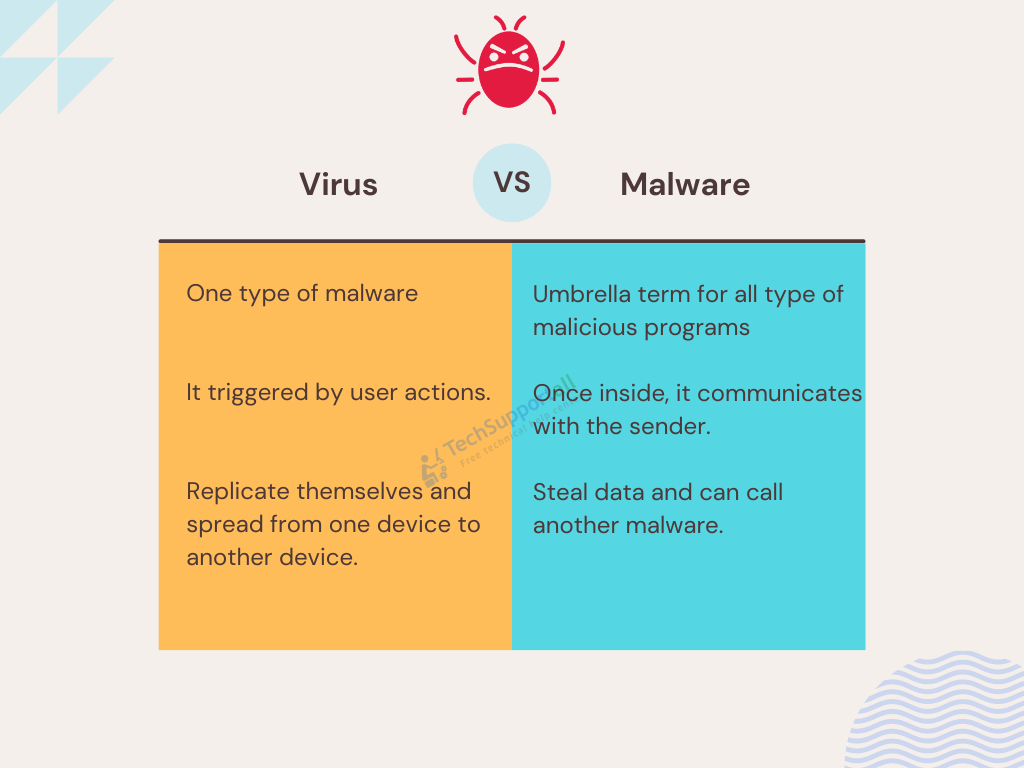Malware and virus are two confusing words in the computer world. Both of these terms refer to harmful software. So to clear up the confusion, let’s find the difference between a virus and malware.
What is a Malware?
Malware is a type of software that is designed to damage or disrupt computer operation, gather sensitive information, or gain access to private computer systems. Malware can be classified into different types depending on what it does.
What is a computer virus
Computer viruses are programs that infect a computer and, without the user’s knowledge, copy themselves to other files or disks. Viruses are one of the most common types of malware and can spread from computer to computer by infecting files on a network or removable storage media such as USB drives.
Difference between Malware and Virus
| Malware | Virus |
| Malware is anything malicious which harm the digital device or the data. | Virus is a malware which spreads from one program to another. |
| Umbrella term for all type of malicious programs | Virus is a kind of malware |
| It triggered by user actions | Once inside device, It communicates with the sender. |
| After virus malware many other new kind of malware emerged like adware, spyware, ransomware, rogue ware etc. Even they are more destructive then viruses, So these days term malware is more accurate to collectively define all these threats. | Virus was the first type of malicious code and is very vast in nature in 90s so term virus and antivirus are more popular. |

Viruses are typically used for malicious purposes while malware usually has a more broad range of goals. For example, a virus might delete all the data on your hard drive while malware may just steal your credit card information without damaging your system at all.
Malware, on the other hand, refers to all harmful codes that can disrupt the regular operation of your computer. These include malware such as viruses, trojans, worms, spyware, adware,. In summary, all viruses are malware, but not all malware are viruses. Malware programs can range from small annoyances such as pop-up advertisements to severe computer harm such as stealing passwords and data or infecting other devices on a network.
In addition, several malware programs are designed to secretly transfer information about your online surfing patterns to marketers and other third parties. Malware cannot harm the hardware of systems and network equipment, but it can harm the data and software existing on the hardware.
Does terms ‘Malware’ and ‘Virus’ are same?
The terms malware and virus are often misused because they are often used interchangeably. However, technically they have different meanings. But in practical they are same thing. Because they both do the harm to the computer or digital devices.
Why people call malware as computer virus
In the 1970s, malware attacks were given the name “viruses.” Due to the lack of cyber security experts at the time and a lack of technical awareness, people thought this term could be used to describe any kind of malware attack. And in the next few years, this term will become very popular for all kinds of cyber attacks. Due to the increased attacks, companies have also named their security products as antivirus software. However, products protect the user from other types of malware as well. So these days the terms Malware and virus refers to the same thing.
Examples of Virus and Malware
There are several type of viruses. The following are the three most frequent examples:
- The file infector may embed itself inside executable files and propagate over a network. A file infector can delete, overwrite, or even reformat a computer’s operating system or hard drive.
- The macro virus exploits applications that support macros. Typically, macro infections arrive as Word or Excel documents or zipped attachments attached to spam email. False file names entice receivers to open infected files, thus activating infections. Macro viruses, an ancient but still prevalent form of malware, remain popular among hackers.
- Polymorphic viruses alter their own code. The virus copies itself and changes its code so that antivirus systems can’t find it.
Malware comprises all forms of harmful software, such as viruses, and may have a number of purposes. Among the most typical aims of malware are:
- Deceive a victim into supplying personal information for the purpose of identity theft.
- Steal credit card or other financial details from consumers.
- Take over many computers in order to perform denial-of-service attacks against other networks.
- Utilize infected machines to mine bitcoin or other coins.
How to get protected from viruses and malware
To keep away these malicious activities there are software tools which are known as Antivirus and Antimalware. Most people are confused which way to go when it comes to deciding between anti-virus and anti-malware. The ultimate question is always which one offers the best security for my computer? Check this post for difference between Antivirus and Antimalware.
Antivirus or Antimalware software are available as free and paid option in the market. Yes many companies provide free antivirus with basic protection features. And an antivirus with firewall and other extra security layers comes with a paid option. You can check out the free vs paid antivirus.
My personal opinion
We began calling bad software as “malware” in the early days of computers because it spread from one computer to another, much like viruses in the real world. However, this is now causing confusion between real-world viruses and malicious computer programs. So it is better to leave the virus word for the real viruses, and let’s start calling computer viruses “malware.”

No comments:
Post a Comment